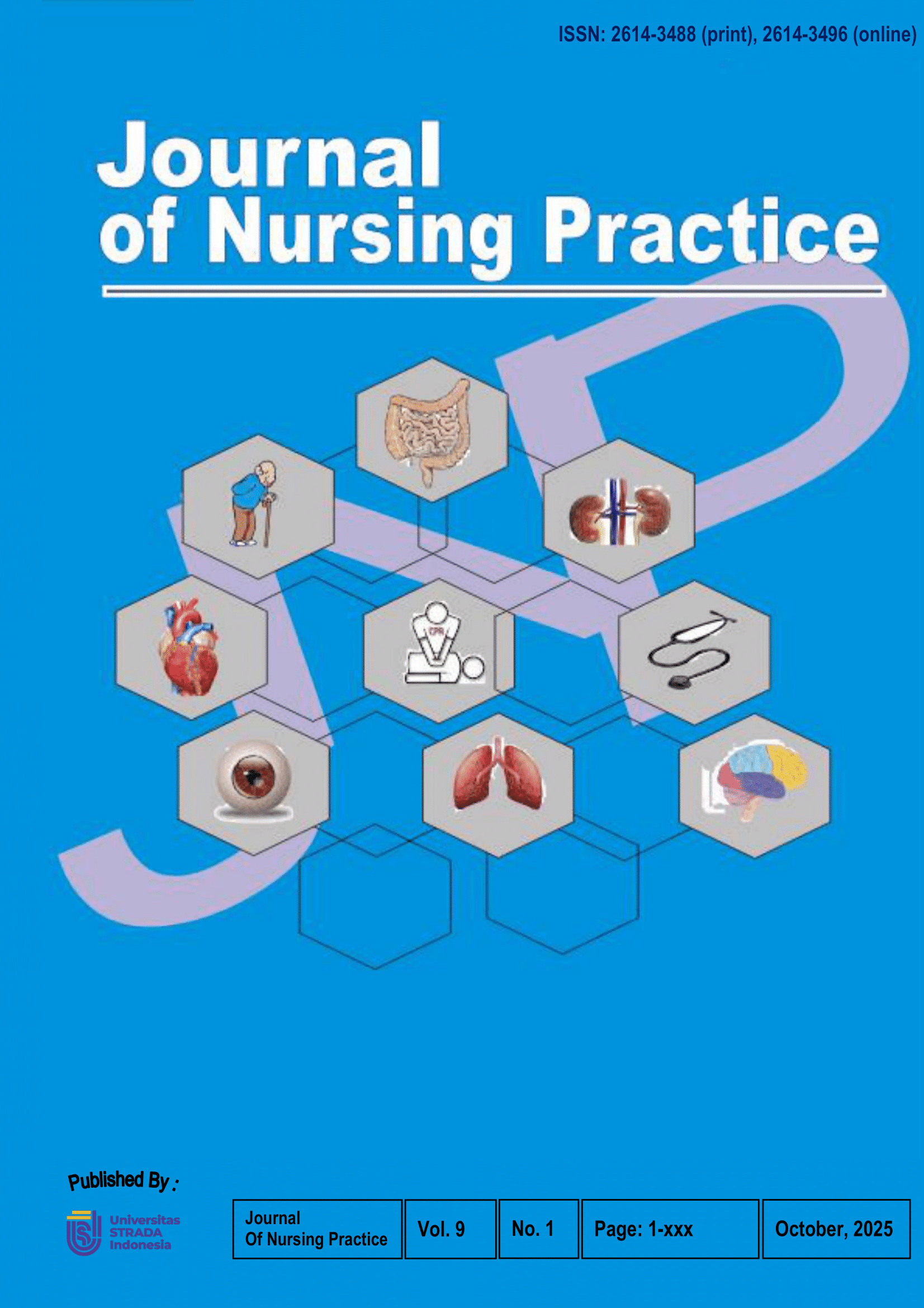Correlation between Stress Levels and Self-Harm Behavior among College Students in Surabaya: Cross-Sectional
Mental Health Nursing
DOI:
https://doi.org/10.30994/jnp.v9i1.919Keywords:
nursing student, self-harm behaviour, stressAbstract
Background: Nursing students experience high stress levels because of the high demands, expectations and activities during their study. Therefore some students struggle to adapt to their college life, eventually resorting to dangerous behaviors such as self-harm, which they perceive as a coping mechanism to relieve stress.
Purpose: This study aims to analyze the relationship between stress levels and self-harm incidents among active students at Universitas Nahdlatul Ulama Surabaya.
Methods: This research design uses descriptive correlational with cross-sectional approach. This study involved 293 students from Universitas Nahdlatul Ulama Surabaya, with purposive sampling technique. The dependent variable in this study is self-harm behavior, while the independent variable is the level of stress. The instrument tools used are the Perceived Stress Scale (PSS) questionnaire and DSHI (Deliberate Self Harm Inventory).
Results: A total of 293 students were sampled in this study. The majority of stress levels were experienced by women, with 135 respondents experiencing moderate stress levels and 118 students having engaged in mild self-harm behavior. The results of the Spearman’s rank statistical test showed a significant correlation between stress levels and self-harm behavior (p-value = 0.004), indicating that higher levels of perceived stress are associated with a greater tendency toward self-harm
Conclusion: This study concluded that the majority of students were under stress, with most perceiving themselves to be experiencing moderate stress. There is an urgent need to identify the underlying causes and implement effective management and preventive measures to mitigate the long-term negative effects of stress on students’ careers and well-being.
Downloads
References
Amelia Azzahra a, Sri Wahyuni b, A. c, & A. (2023). The Relationship between Academic and Non-Academic Stress and Self-Harm Behavior in Riau Amelia University Students . 6 (1), 1–12.
Asif, S., Mudassar, A., Shahzad, T. Z., Raouf, M., & Pervaiz, T. (2020). Frequency of depression, anxiety and stress among university students. Pakistan Journal of Medical Sciences , 36 (5), 971–976. https://doi.org/10.12669/pjms.36.5.1873.
Bayantari, NM, Indonesiani, SH, & Apsari, PIB (2022). Self-Regulation in Learning and Its Relationship with Academic Stress in First-Year Medical Students. Scientific Journal of Education and Learning , 6 (3), 609–618. https://doi.org/10.23887/jipp.v6i3.51175.
Cuijpers, P., Smit, F., Aalten, P., Batelaan, N., Klein, A., Salemink, E., Spinhoven, P., Struijs, S., Vonk, P., Wiers, R. W., de Wit, L., Gentili, C., Ebert, D. D., Bruffaerts, R., Kessler, R. C., & Karyotaki, E. (2021). The Associations of Common Psychological Problems With Mental Disorders Among College Students. Frontiers in Psychiatry, 12(September), 1–9. https://doi.org/10.3389/fpsyt.2021.573637.
Krismonica, P., Palumpun, E., Lase, E., Paula, V., & Silitonga, E. (2024). Levels of Stress, Anxiety, and Depression in First-Year Nursing Students During Online Learning During the Covid-19 Pandemic. MAHESA: Malahayati Health Student Journal , 4 (1), 9–18. https://doi.org/10.33024/mahesa.v4i1.10836.
Kusumadewi, A. ., Yoga, BH, & Ismanto, S. (2019). Indonesian Version of Self-Harm Inventory (Shi) as an Early Detection Instrument for Self-Harm Behavior. Surabaya Journal of Psychiatry , 8 (1), 20–25.
Nappoe, BC, & Triwahyuni, P. (2025). Academic Stress Levels in First-Year Nursing Students. Journal of Telenursing , 7 (2), 342–349.
Osborn, T.L., Wasanga, C.M., & Ndetei, D.M. (2022). Transforming mental health for all. In The BMJ . https://doi.org/10.1136/bmj.o1593.
Pilar Matud, M., Díaz, A., Bethencourt, J.M., & Ibáñez, I. (2020). Stress and psychological distress in emerging adulthood: A gender analysis. Journal of Clinical Medicine , 9 (9), 1–11. https://doi.org/10.3390/jcm9092859.
Rahmadina, R., & Eka Putri, YS (2023). Differences in Academic Stress Levels in Final-Year Nursing Students During the Adaptation Period to the Covid-19 Endemic. National Health Research Journal , 7 (2), 91–97. https://doi.org/10.37294/jrkn.v7i2.489.
Saridewi Mutiara Insani. (2022). Case Study: Factors Causing Self-Harm Behavior in Adolescent Girls. Journal of Psychological Research , 10 (02), 439–454.
Setyanto, AT (2023). Early Detection of the Prevalence of Mental Health Disorders in College Students. Discourse , 15 (1), 66. https://doi.org/10.20961/wacana.v15i1.69548.
Shafira, AN, & Hargiana, G. (2022). Self-Harm Behavior among Nursing Students. Jurnal Kesehatan , 11 (2), 123–134. https://doi.org/10.46815/jk.v11i2.83.
Tang, F., Byrne, M., & Qin, P. (2018). Psychological distress and risk for suicidal behavior among university students in contemporary China. Journal of Affective Disorders , 228 (October 2017), 101–108. https://doi.org/10.1016/j.jad.2017.12.005
World Health Organization. (2022). Mental health of higher education students. https://www.who.int/publications/i/item/9789240062261.
Downloads
Published
How to Cite
Issue
Section
License
Copyright (c) 2025 Journal Of Nursing Practice

This work is licensed under a Creative Commons Attribution-NonCommercial-ShareAlike 4.0 International License.

This work is licensed under a Creative Commons Attribution-NonCommercial-ShareAlike 4.0 International License.






















